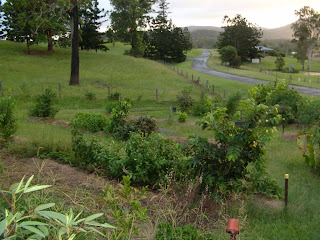About one year ago, the swale orchard started taking development. I had previous started the top SE swale/trench and planted two Small Leaf Jaboticabas and a Lemon Myrtle. I also planted other useful plants such as Pigeon Pea, Rosella, and Egyptian Spinach. Since that time I extended the start of the swale so that all the overflow from the rainwater tanks flow through it.
The next picture shows the lay of the land before development of the future swale orchard.
The future swale locations were mapped out using a spirit level, old wooden ladder, and lots of grass clippings. For some reason I neglected to take any pictures when the contour lines were first set out, but they were a maximum of 4.8 m apart, but often merging much closer as they aligned with the contours. Below are some pictures taken around the beginning of May 2010 after planting had been started.
This picture is taken from the main path through the centre of the orchard looking towards the start of the driveway. In the foreground one can see a Bignay or Red Currant Tree (Antidesma bunius). At the next swale to the left is a Black Sapote. As well in the background, there are a Spanish Cherry or Bakul Tree (Mimusops elengi), Hawaiian Guava, Asenia triloba, and Jakfruit (Blackgold).
This picture is taken from the start of the driveway looking through the orchard towards the north east. There are Jakfruit, Vietnamese Mint, local feral Guava, Loquat, Saba Nut or Malabar Chestnut (Pachira aquatica), and Taro planted out.
This picture is also from the same location, but looking towards the east. The Asenia triloba are in the pink protective plant guards and the Hawaiian Guava is to the right.
While it can be seen that many of the plants raised about the "natural" ground, I since found that with settling this was not nearly enough. So I know put much more effort into raising the level for the planting of each tree.
So how do things look now...
This is now the view from the top of the main path down the centre of the orchard towards to the start of the driveway. Note incredible growth of the Red Currant Tree. (Yes the neighbouring bloodwood tree continues to shed branches during heavy winds.)
Next is the view from the start of the driveway looking north east. Note the growth of the feral Guava and the Vietnamese Mint on the far left. The Cassava blocks the view of most of the rest of the orchard.
This time we are looking towards the east from the same location. Note the growth of the Hawaiian Guava.
Now for the overall view.
I have found that the effort in making the swales out of compost, using on-the-spot composting techniques, has been extremely successful. The plants are really responding to the nutrient rich soil. For some trees it is a bit much, such as the Custard Apple and Spanish Cherry. These trees suffer from scale attack and the usual associated problems. The Spanish Cherry is particularly vulnerable to scale.
As I have been building up the swales over time, I have had problems during some heavy rain events with low points on the swales being washed downhill (although not off the property). This was particularly the case when a number of uphill swales were only partially completed. This problem has almost been addressed now, with only a few swales not completed and there are no longer multi-swale gaps.
As the plants get settled into their places and the soil life builds up, I have been seeing trees such as the Carambola (Averrhoa carambola) putting on huge amounts of growth. Our unseasonably wet spring and heavy rain periods have been great for the growth of the trees. None have had any problems with root rot.
As for fruits, I have been enjoying some Acerola Cherries. This tree is simply amazing in its output. It has only been in the ground for about 4 months and has been supplying a trickle of fruit for the entire period. But now it is really starting some serious production. Goodbye vitamin C tablets!










Looks awesome! I'm sure those trees will be pumping out the food within a couple of years.
ReplyDeleteOut of interest, how do you stop the grass from encroaching back onto the swales? That's one of my biggest problems.
Running grasses will always be a challenge to manage for any garden area, including swales. This is particularly the case for newly established garden beds. I do not have kikuyu grass in the orchard, so the invasion problem is relatively easy to manage.
ReplyDeleteI have found that mowing over the edge of the swale slows the incursion. As well heaping up significant amounts of grass/mulch along the edge of the swales helps (see the picture with the fence-line when the orchard was first planted out as an example).
I have also started getting some pinto peanut started in this orchard. Once established, it is exceptional at being able to keep grass at bay. Again kikuyu might be a different story (the best thing to beat kikuyu is lots of shade). The pinto peanut has been holding its own in the citrus orchard where I have let it get quite feral over about 6 months.